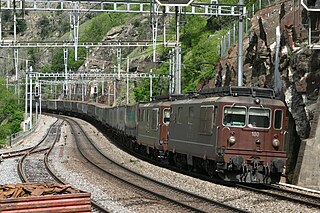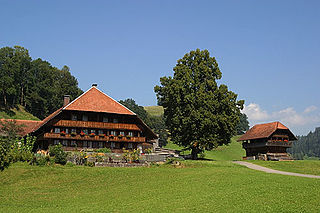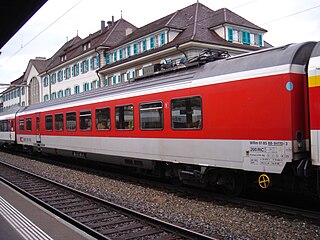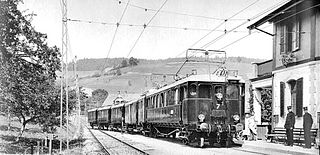Related Research Articles

The Aare or Aar is a tributary of the High Rhine and the longest river that both rises and ends entirely within Switzerland.

The Bern-Lötschberg-Simplon-Bahn (BLS), known between 1997 and 2006 as the BLS Lötschbergbahn, was a Swiss railway company. In 2006 the company merged with Regionalverkehr Mittelland AG to form a new company called BLS AG.

The canton of Bern, or Berne, is one of the 26 cantons forming the Swiss Confederation. Its capital city, Bern, is also the de facto capital of Switzerland. The bear is the heraldic symbol of the canton, displayed on a red-yellow background.
On 26 June 1964, Swiss Post introduced postal codes as the third country after Germany (1941) and the United States (1963).

There are 335 municipalities in the canton of Bern, Switzerland.
Gsteig may refer to:

The Emmental is a valley in west-central Switzerland, forming part of the canton of Bern. It is a hilly landscape comprising the basins of the rivers Emme and Ilfis. The region is mostly devoted to farming, particularly dairy farming. The principal settlements are the town of Burgdorf and the village of Langnau.

Districts of Switzerland are a political subdivision for cantons. In the federally constituted Switzerland, each canton is completely free to decide its own internal organisation. Therefore, there exists a variety of structures and terminology for the subnational entities between canton and municipality, loosely termed districts. Most cantons are divided into Bezirke. They are also termed Ämter, Amtsbezirke, district or distretto. The Bezirke generally provide only administration and court organization. However, for historical reasons districts in cantons Graubünden and Schwyz are their own legal entities with jurisdiction over tax and often have their own Landsgemeinde.

The Bernese Oberland, sometimes also known as the Bernese Highlands, is the highest and southernmost part of the canton of Bern. It is one of the canton's five administrative regions. It constitutes the Alpine region of the canton and the northern side of the Bernese Alps, including many of its highest peaks, among which the Finsteraarhorn, the highest in both range and canton.

Hasle bei Burgdorf is a municipality in the administrative district of Emmental in the canton of Bern in Switzerland.

Gsteig bei Gstaad is a municipality in the Obersimmental-Saanen administrative district in the canton of Bern in Switzerland. Gsteig was formerly known by the French name of Châtelet.
Regionalverkehr Mittelland AG (RM) was a 1997 merger of

BLS AG is a Swiss railway company created by the 2006 merger of BLS Lötschbergbahn and Regionalverkehr Mittelland AG. 55.8% of it is owned by the canton of Berne, and 21.7% by the Swiss Confederation. It has two main business fields: passenger traffic and infrastructure.
Seeland District in the Canton of Bern was created on 1 January 2010. It is part of the Seeland administrative region. It contains 42 municipalities with an area of 334.14 km2 (129.01 sq mi) and a population of 76,052.
On 1 January 2010, the 26 districts were combined into 10 new precincts :

Thun is a railway station in the town of Thun, in the Swiss canton of Bern. At the station, the Swiss Federal Railways owned Bern to Thun main line makes a junction with the other lines, all owned by the BLS AG. These lines are the Gürbetal line from Bern via Belp, the Burgdorf to Thun line from Burgdorf via Konolfingen, and the Lake Thun line to Spiez and Interlaken.

The Burgdorf–Thun railway is a railway line in Switzerland, which was built by the Burgdorf-Thun-Bahn. The line from Burgdorf via Konolfingen to Thun was opened by the company in 1899 as the first electrified mainline railway in Europe. It is now part of BLS AG.
The Solothurn–Langnau railway is a railway line in the Emmental in Switzerland. It was built by the Emmentalbahn, which was based in Burgdorf. The line runs from Solothurn via Burgdorf to Langnau im Emmental. It is now part of BLS AG.

Schafhausen im Emmental railway station is a railway station in the municipality of Hasle bei Burgdorf, in the Swiss canton of Bern. It is located on the standard gauge Burgdorf–Thun line of BLS AG.
The Libero-Tarifverbund is a Swiss tariff network covering the canton of Bern and the southwestern part of the canton of Solothurn. It was established in December 2004 from the merger of the Bäre-Abi and Frosch-Abo tariff networks. The Zig-Zag network merged into Libero in 2014. With the merger of the Tarifverbund Berner Oberland ("BeoAbo"), covering the Bernese Oberland, in December 2019, the network covers the entire canton of Bern.
References
- ↑ "Address data base of Reformed churches and institutions". www.reformiert-online.net.
- ↑ "Synode: Reformierte Kirchen Bern-Jura-Solothurn". www.refbejuso.ch.
- ↑ "Kirchgemeinden: Reformierte Kirchen Bern-Jura-Solothurn". www.refbejuso.ch.
- ↑ Reformierte Kirchen Bern-Jura-Solothurn: Feiern in besonderen Lebenslagen (German)
- ↑ "www.refbejuso.ch/publikationen/links/kirchgemeinden-bezirke.html".